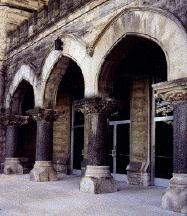Historians trace the origins of the map coloring problem to Francis Guthrie, a nineteenth century cartographer. Francis' brother, Fredrick, was a student of mathematics and so he naturally asked his brother whether it was known that only four colors were sufficient to color a geographic map of distinct regions. Fredrick passed the problem onto Augustus De Morgan who wondered whether a necessity for five colors could not be contrived.
It occurs that such a necessity and more exists on the torus as well as other well known surfaces such as the Klein bottle. We will investigate the coloring of maps on various surfaces and show that the topology of the surface plays an important role.
The colloquium will begin at around 4 pm in Old Main 2231.
Friday, February 26, 2010
Monday, February 15, 2010
Thursday, February 11, 2010
Who am i?
a complex ol creature am i
O this negative radical guy
as i travel in fours
all out thru my pores
will flow my idenitie
O this negative radical guy
as i travel in fours
all out thru my pores
will flow my idenitie
Friday, February 5, 2010
Challenge of the Week
The Department sponsors a problem solving competition for undergraduates at the university with a new challenge each week or so. We will feature some of the old problems on this blog, but changed slightly. Here is an example
Suppose that we have two rational numbers whose sum is negative 9 times their product and the sum is also negative 16 times their quotient. Find the two numbers.
x+ y = -9(xy)
x+y = -16(x/y)
Find x and y.
Suppose that we have two rational numbers whose sum is negative 9 times their product and the sum is also negative 16 times their quotient. Find the two numbers.
x+ y = -9(xy)
x+y = -16(x/y)
Find x and y.
Subscribe to:
Comments (Atom)

